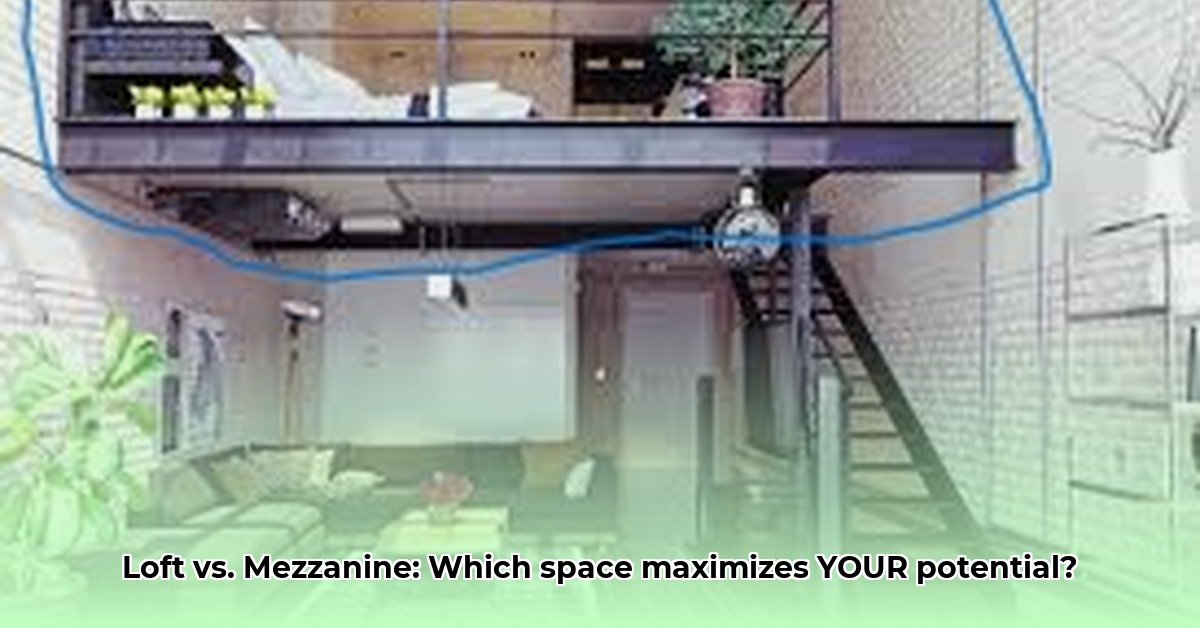So, you’ve got a building and need more space. A loft conversion or a mezzanine? It’s a big decision that can really affect how your business runs and how much money you make. This guide will walk you through everything you need to know to make the right choice. We’ll look at the pros and cons of each, talk about the costs and building rules, and even help you plan for the future. Whether you’re a business owner or an expert, this guide will give you the knowledge to pick the best solution for your space.
Loft vs Mezzanine: Which Space Solution is Right for You?
Thinking about expanding your industrial workspace and optimizing storage solutions? You’ve probably heard of lofts and mezzanines – but what’s the difference, and which one is right for you? Let’s break it down in simple terms and review space utilization techniques.
Understanding Lofts and Mezzanines: The Basics of Space Expansion
Imagine you have a giant warehouse with soaring ceilings. A loft is like opening up that unused vertical space, creating a new area within the existing structure. Think of it as a major renovation, often involving significant changes to the building’s layout and possibly even its structure. It’s a big project, quite often a complete overhaul of that particular area. Lofts are frequently found in older buildings that have been repurposed.
A mezzanine, on the other hand, is more like adding a new floor, a platform, within your existing space. Picture it as a separate level, typically supported by columns or walls, that sits above the main floor. It’s a more modular approach; it’s like building a second level on top of what you already have. It’s generally easier to install and, in some cases, even remove. Mezzanines are often constructed from steel and can be customized to fit specific needs.
Choosing between a loft and a mezzanine depends entirely on your specific needs and situation. Let’s explore the factors you need to consider when optimizing industrial space. Did you know, that the cost of expanding industrial space varies greatly, and unforeseen structural issues can double the initial estimate? According to a recent study by the National Association of Industrial and Office Properties (NAIOP), businesses can increase their operational efficiency by up to 40% when optimizing their existing space.
Key Factors to Consider: Making the Right Choice for Industrial Space Optimization
Deciding between a loft and a mezzanine involves more than just space; it’s about planning, budget, and the nature of your structure. Here’s a closer look at what matters:
- Ceiling Height: Lofts demand seriously tall ceilings, typically over 15 feet. You need enough headroom to create that usable space, comply with safety regulations, and ensure comfortable movement. Mezzanines, while needing sufficient height for construction and movement, have significantly less stringent height requirements, often working well in spaces with ceilings around 12 feet.
- Cost: Mezzanines typically have a more predictable upfront cost, generally ranging from \$20 to \$40 per square foot. You get a clearer picture of the expenses before you even start. Lofts, however, can be trickier. Unforeseen structural problems during a loft conversion might dramatically increase the overall cost, sometimes even doubling or tripling the initial estimate. Loft conversion costs can easily exceed \$100 per square foot due to extensive modifications.
-
Structural Integrity: Both loft conversions and mezzanine installations require a thorough assessment by a structural engineer. Mezzanines need strong supports to hold the weight they’ll carry, with weight limits clearly defined and enforced. Lofts, because they modify the existing structure, necessitate an even deeper evaluation to ensure the building’s stability after the conversion, requiring adherence to strict building codes.
-
Flexibility and Adaptability: Mezzanines are usually easier to remove or alter later on if your needs change. Think of them as more easily adjustable components of your space. Free-standing mezzanines offer even greater flexibility. Lofts, however, are much more integrated into the building’s structure, making future modifications more complicated and expensive, often requiring new permits.
- The “Look”: Aesthetics and Design: Lofts often create a more dramatic, open architectural feel. They can significantly alter the building’s aesthetic, creating a unique industrial style, often showcasing exposed brick or original beams. Mezzanines, generally, tend to fit more seamlessly within the existing space, less disruptive to the current overall design. The design impacts lighting, ventilation, and overall workspace ergonomics.
Consider what you want your final space to look like. Do you prefer a bold, modern statement, or a more functional and integrated solution? This aesthetic consideration should significantly influence your decision. Also, contemplate how the design will impact natural light and ventilation.
The Practicalities: Construction and Regulations – A Step-by-Step Guide to Building Permits
Before you even start dreaming about your new space, familiarize yourself with local building codes and regulations. Getting the necessary permits is crucial for both lofts and mezzanines. Remember: failing to follow regulations can lead to delays, hefty fines, and even the demolition of your project. Always consult structural engineers and contractors who have experience with the specific project you’re undertaking – this professional guidance is invaluable. What are the fire safety regulations for mezzanines and lofts, and how do they impact design and construction? Fire-resistant materials, sprinkler systems, and clearly marked exits are mandatory in most jurisdictions.
Building a Mezzanine: A Step-by-Step Process
- Planning and Design: This involves creating detailed plans, including thorough load-bearing calculations to ensure the mezzanine’s stability and safety. You’ll need to account for the weight it will bear, ensuring the existing floor and support structures can handle the addition. Software like AutoCAD or Revit is often used for precise design.
- Permitting: Obtain all the necessary permits from your local authorities. This stage requires careful attention to detail and adherence to all regulations. Required documents typically include architectural drawings, structural calculations, and fire safety plans.
- Construction: This phase involves the actual building of the mezzanine: erecting the support structures, installing flooring, and adding safety features like railings and guardrails. Throughout this process, meticulous adherence to building codes is essential. Certified welders and experienced construction crews are critical for a safe and compliant build.
- Inspection: Finally, a thorough inspection is done to verify compliance with building codes and safety standards. This inspection is crucial to ensure everything is safe and up to code. Inspections often cover structural integrity, fire safety compliance, and accessibility.
Creating a Loft Conversion: A Step-by-Step Process
- Structural Assessment: Before you even think about design, you must have a professional structural engineer assess your building. This evaluation will determine the feasibility of a loft conversion and identify any potential structural limitations or weaknesses. This may involve extensive testing and analysis of the building’s framework. Soil testing and foundation analysis might be necessary in some cases.
- Planning and Design: Based on the assessment, design plans are developed, taking into account any structural limitations or reinforcements needed. These plans may also include aspects like new plumbing, electrical work, and lighting. Energy-efficient designs are increasingly popular to minimize long-term operating costs.
- Permitting: The process of obtaining the needed permits can be complex, particularly for historical structures or buildings in designated heritage zones. These permits ensure your project meets all local regulations and safety standards. Engaging a permit expediter can streamline this complicated process.
- Construction: The actual conversion process requires specialized expertise and careful execution. Structural reinforcement may be necessary, and the work may encompass extensive renovations. Skilled carpenters, electricians, and plumbers are essential for a successful loft conversion.
- Inspection: The final inspection is vital to ensure complete compliance with all building codes and safety regulations. Final inspections often cover electrical, plumbing, and structural compliance.
Loft vs. Mezzanine: A Quick Comparison of Industrial Space Options
| Feature | Loft | Mezzanine |
|---|---|---|
| Initial Cost | Typically higher, less predictable | Usually lower, more predictable |
| Required Ceiling Height | Significantly higher | Moderate |
| Adaptability | Less adaptable; changes can be costly | More adaptable; changes are usually easier |
| Aesthetic Impact | More dramatic, often alters building style | Usually blends more seamlessly with existing structure |
| Structural Complexity | More complex; greater potential for issues | Relatively less complex |
| Typical Load Capacity | Generally lower | Generally higher |
| Construction Time | Longer, due to structural modifications | Shorter, often prefabricated |
The Final Verdict: Which One’s Right for You for Maximizing Warehouse Space?
Ultimately, the “best” choice – loft or mezzanine – depends entirely on your specific situation. Consider your budget, the structural capabilities of your building, your future expansion plans, and your overall design goals. A thorough assessment, including advice from qualified professionals, is crucial. Remember that following building regulations is not just a suggestion; it’s a legal necessity. By carefully weighing these factors and seeking expert advice, you can select the solution that best optimizes your industrial workspace and ensures a successful project. Prefabricated mezzanines can offer quicker installation times, but do they compromise on structural integrity
- Gray Kitchen Backsplash Ideas: Find Your Perfect Gray Tile - December 11, 2025
- Glass Wall Tiles For Bathroom: A Stylish, Durable Choice - December 10, 2025
- Glass Mosaic Kitchen Backsplash: Add Shimmer and Style - December 9, 2025









